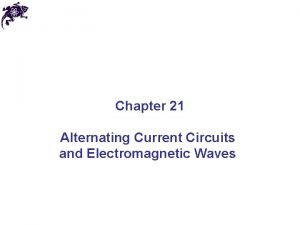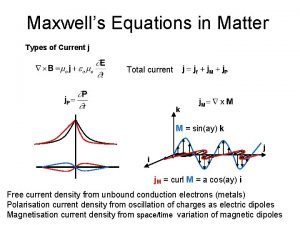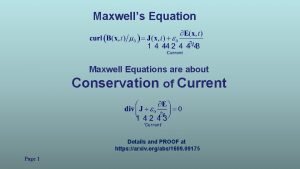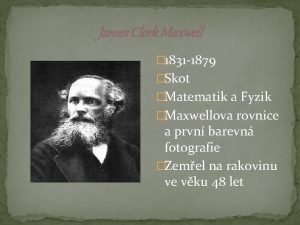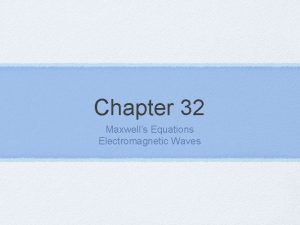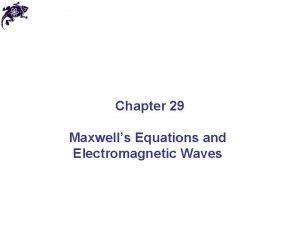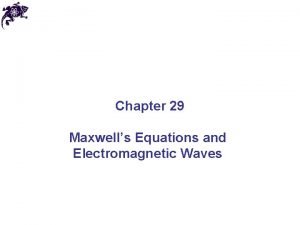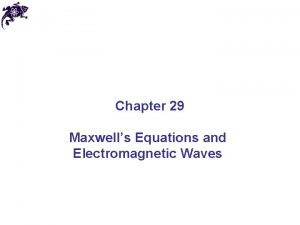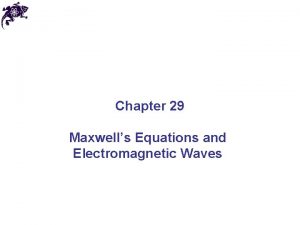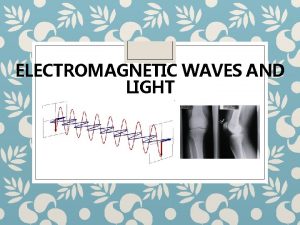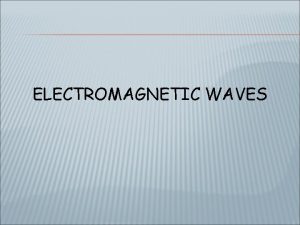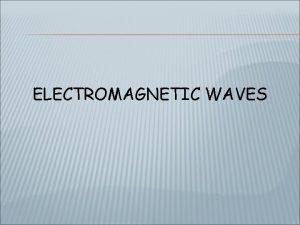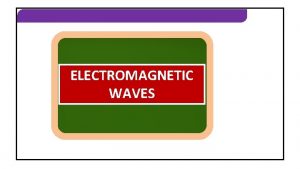Electromagnetic Waves Maxwells Equations Maxwells Displacement Current Animation












- Slides: 12

Electromagnetic Waves • Maxwell’s Equations • Maxwell’s Displacement Current • Animation – EM Waves • Properties of EM Waves • Electromagnetic Spectrum • Radio Frequency Spectrum • Encoding Information

Maxwell’s Equations • Google • Wikipedia missing term!

Maxwell’s Displacement Current • Capacitor Charging – What happens in the “missing current” region? • Maxwell added a “displacement current” εoμo Δφ/Δt • Made 4 equations complete for all EM phenomena

Electromagnetic Waves • Gauss’s (Coulomb’s) Law and Ampere’s Law setup electric and magnetic fields. • Faraday Induction and Displacement Current continue selfsustaining electromagnetic wave. • Satisfies basic wave equation, theory predicts speed of light! • Can be created by resonating wire with L = λ/4 similar to wind instruments. • Propagate at all frequencies and wavelengths. • Electromagnetic spectrum.

EM Wave Animation http: //phet. colorado. edu/en/simulation/radio-waves • Gauss’s Law sets up E, Ampere’s Law sets up B • Faraday Induction and Displacement current keep it going • Whole thing travels at 3 x 108 m/s (speed of light)

The Electromagnetic Spectrum • Radio Frequency – Radio, TV, cellphone, satellite, wifi, bluetooth, shortwave • • • Infrared Visible Ultraviolet X-ray Gamma-ray Ionizing radiation

US Communications frequencies

• • • • • • • • • Popular communications frequencies United States A brief summary of some UHF frequency use: 88 – 108 MHz: FM Broadcasting 108– 135 MHz: Aircraft control 225– 420 MHz: Government use, including meteorology, military aviation, and federal two-way use[26] 420– 450 MHz: Government radiolocation and amateur radio (70 cm band) 433 MHz: Short range consumer devices including automotive, alarm systems, home automation, temperature sensors 450– 470 MHz: UHF business band, General Mobile Radio Service, and Family Radio Service 2 -way "walkie-talkies", public safety 470– 512 MHz: TV channels 14– 20 (also shared for land mobile 2 -way radio use in some areas) 512– 698 MHz: TV channels 21– 51 (channel 37 used for radio astronomy) 698– 806 MHz: Was auctioned in March 2008; bidders got full use after the transition to digital TV was completed on June 12, 2009 (formerly UHF TV channels 52– 69) 806– 824 MHz: Public safety and commercial 2 -way (formerly TV channels 70– 72) 824– 851 MHz: Cellular A & B franchises, terminal (mobile phone) (formerly TV channels 73– 77) AT&T, Verizon Wireless 851– 869 MHz: Public safety and commercial 2 -way (formerly TV channels 77– 80) 869– 896 MHz: Cellular A & B franchises, base station (formerly TV channels 80– 83) 902– 928 MHz: ISM band, amateur radio (33 cm band), cordless phones and stereo, radio-frequency identification, datalinks 929– 930 MHz: Pagers 931– 932 MHz: Pagers 935– 941 MHz: Commercial 2 -way radio 941– 960 MHz: Mixed studio-transmitter links, SCADA, other. 960– 1215 MHz: Aeronautical Radionavigation 1240– 1300 MHz: Amateur radio (23 cm band) 1452– 1492 MHz: Military use (therefore not available for Digital Audio Broadcasting, unlike Canada/Europe) 1575 MHz: Global Positioning System 1710– 1755 MHz: AWS mobile phone uplink (UL) Operating Band 1850– 1910 MHz: PCS mobile phone—order is A, D, B, E, F, C blocks. A, B, C = 15 MHz; D, E, F = 5 MHz T-Mobile, Sprint PCS 1920– 1930 MHz: DECT Cordless telephone 1930– 1990 MHz: PCS base stations—order is A, D, B, E, F, C blocks. A, B, C = 15 MHz; D, E, F = 5 MHz 2110– 2155 MHz: AWS mobile phone downlink (DL) Operating Band 2300– 2310 MHz: Amateur radio (13 cm band, lower segment) 2310– 2360 MHz: Satellite radio (Sirius and XM) 2390– 2450 MHz: Amateur radio (13 cm band, upper segment) 2400– 2483. 5 MHz: ISM, IEEE 802. 11, 802. 11 b, 802. 11 g, 802. 11 n Wireless LAN, IEEE 802. 15. 4 -2006, Bluetooth, Zig. Bee, Microwave oven

Information Encoding • Amplitude Modulation • Frequency Modulation • Digital Techniques – GSM/CDMA/W-CDMA/OFDM /LTE (US Cellular) – ATSC (US Digital Television) – HD Radio

Nerd T-Shirts Order: 1) small, medium, large, x-large, and 2) differential or integral form Search: “Maxwell’s equations T-shirt”

Final comment • And a 16 -year old Swiss student worried about one detail…

End of Electricity and Magnetism (in good years, I do 3 classes of optics)
 High and low frequency waves
High and low frequency waves Sound waves are transverse waves true or false
Sound waves are transverse waves true or false Mechanical and electromagnetic waves similarities
Mechanical and electromagnetic waves similarities Similarities of mechanical and electromagnetic waves
Similarities of mechanical and electromagnetic waves Mechanical waves and electromagnetic waves similarities
Mechanical waves and electromagnetic waves similarities Examples of mechanical and electromagnetic waves
Examples of mechanical and electromagnetic waves Mechanical and electromagnetic waves similarities
Mechanical and electromagnetic waves similarities What do all waves transmit
What do all waves transmit Alternating current circuits and electromagnetic waves
Alternating current circuits and electromagnetic waves Maxwells equations in matter
Maxwells equations in matter Maxwells equations
Maxwells equations Maxwells equations
Maxwells equations Magnetism equations
Magnetism equations








